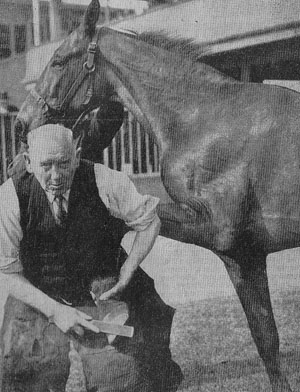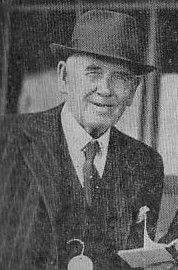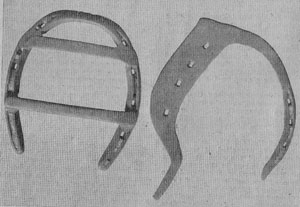| PEOPLE |
YEAR: 1944
 |
| Fred Johnston & Zingarrie |
Fred Johnston has been shoeing horses for 54 years. He is the official farrier at Addington meetings.
This maestro of the anvil chorus opened a blacksmith shop in Sydenham in 1890, and down through the years, under his "spreading chestnut tree" have stood such celebrities as Red Child, Kentucky, Thelma, Bellflower, Durbar, Marian, Aberfeldy, Dan Patch, Author Dillon, Admiral Wood, Wildwood Junior and hundreds more. And Fred is still on the job. When I looked him up on Saturday he was deftly rasping away at a nimble foot belonging to Zingarrie.
Fred paused in his rasping to answer my question: "Wildwood Junior was the best horse I ever shod," he replied. "He won two Cups, and his third would have been easy if he hadn't gone wrong. The black horse's shoes weighed only 13oz in all. We had made some progress even in those days, as you see," added Johnston, "but what a headache the early trotters used to give us! They were nearly all speedy-cutters, and the pacers were mostly cross-firers, and I used to lie awake night after night trying to puzzle out ways and means of improving their gait. You see, in the early days the breed wasn't there. The farrier was expected to make trotters out of cart horses. Today, they are so well bred they are gaited, so to speak, as soon as they are foaled."
Fred Johnston mopped his brow. He had just been all through the throes and anxieties of levelling up the footwork of a particularly bad knee-knocker he had to deal with 40 years ago. The mere recital of it made him feel like the village smithy of old, and honest sweat glistened in beads on his brow.
"Knee-knockers!" he exclaimed, while continuing the mopping. "They were at their worst 40 years ago. Today few knee-knockers are worth going on with. It was always a hard defect to attempt to cure. When Peter Riddle first came to this country with a team of horses, I had the pleasure of doing his shoeing. He said: 'If you can't get a horse that doesn't knock its knees, don't have one at all.' That's what he thought of knee-knockers. Gus Milsom was of the same opinion: so was the late Bob McMillan," added Johnston. "But in the early days we had no option," continued our worthy smith. "There were few good-gaited horses about."
Johnston went into some detail to explain what a scalper is, and instanced the case of a great trotter named Red Child, who raced about 50 years ago. Red Child scalped very badly. It was impossible to race him without scalping boots on the hind feet to protect him from striking himself with his front feet. Many a headache he gave me before I got him right," said Johnston.
"But I had a worse case than that. It was McKinley, a horse I owned myself, and the worst cross-firer I ever had. I could have slept in peace if I had had the knowledge in the year 1902 I gained in later years. McKinley pulled so many front shoes off he nearly had me in the asylum. But when I did get him to rights he was a good horse."
"What do you regard as your greatest shoeing triumph?" I asked the man of the forge.
Without a moment's hesitation Fred answered: "A trotter called Impatient." He went on to relate how Randall McDonnell had a horse of that name, and wanted to race him at Addington. "I asked Randall if the horse had any defects, and he answered: 'Yes; he paddles in front and dwells behind.' That wasn't so simple; but I took his shoes off and weighed them, and asked Randall what weight he wanted on the horse. His reply was; 'He's in your hands; do what you think best.' I decided to lower the heels of his front feet a quarter of an inch, but that made a longer toe on his front feet. I put three ounces more weight on him than he had before, and made his hind shoes three ounces lighter. Then I put good caulks on the heels, and rolled the toes of the hind shoes. Randall worked him next day, went to the races, and won a three-mile race with him. He did not put a foot wrong. I still consider that was my master-piece," said Johnston reflectively.
"Round about 1897 Bob Day came to Sydenham with a team of horses, among them Gazelle, a trotter, and the first to break five minutes for two miles at Lancaster Park. I mention this mare in particular because she was easy to shoe, wearing only a 4oz shoe on each foot. Bob Day, incidentally, is still hale and hearty, and was at the last matinee meeting at Brighton," added Johnston.
"No foot, no horse! That axiom is as true today as ever it was," said Johnston. The foot was the one essential thing about a horse; a defect in any other part may not make it useless, but a bad foot could make it unsuitable for anything except breeding. "If all horses were straight-legged and sound in bones and hooves, the task of the trainer would be greatly simplified," said our farrier, "and there would be no headaches for us."
Nature however plays her little pranks with horseflesh just as she does with humans, and the horse is prone to the same freakish twists and deformities that beset the human race. What science, veterinary skill and balancing have done to correct these deficiences with the aid of modern shoeing methods forms a fascinating study. Much of the improvement in pacing and trotting speed is due to the particular genius of men like Fred Johnston. His life-long struggle for balance in gait has led him to explore many avenues in equine chiropody; in fact, the trotting footwear specialist is one of the most important units in the game.
Although horse-shoes have been made for many centuries, and their general design has not changed, and presumably never will, there have been many refinements. Fifty years ago, Fred Johnston will tell you, it was no uncommon thing for harness horses to wear shoes each weighing a pound or more, but today shoes are made as light as possible, commensurate with proper protection.
Fred was always sending to America for shoeing data in the early days, and he attributes some of his success to the information he was able to get from a shoers journal published by the late Wm. Russell, an expert in the craft. The Americans have naturally always been in the forefront in the shoeing of the trotting horse, because there the standard-bred as we know it today originated. And what a story the history of American shoeing tells us! Weight has been gradually decreased from the terrific load of two pounds on each foot to less than a pound on the whole four!
Some of the early colt trotters carried excessive weight, and Belle Nara, 2.08ż, who in 1888 lowered the world's record for yearlings in a race, to 2.38, carried almost two pounds in shoe and toe-weight, on each foot. Even 10 years later the amount of weight carried by the cracks resembled, in many instances, the old-timers rather than the modern colt. A conspicuous instance was Peter The Great. It took a lot of iron to balance him, but few were aware just how much. The statement appears that he won the Kentucky Futurity of 1898, carrying a 12oz shoe and 5oz toe-weight on each foot. Five years later, when Lou Dillon made the two-minute trotter a reality, she wore shes that weighed 4Żoz each in front, and 3Żoz each behind. She wore no toe-weights.
Brittle-footed horses are always a problem. Indianapolis was one of the worst cases ever experienced in this country. His feet were very dry and brittle, and before he won his first NZ Cup one of the front hooves split from top to bottom, and the blood was oozing out. A clever riveting operation by the late E Archer, another celebrated man of the anvil, enabled the big pacer to carry on and win three Cups; but if the delicate operation to his foot had been out so much as a hair's breadth, he would never have raced again.
Even in the early days of man attention had been drawn to the brittle nature of the horses hoof, for in Judg. v22 we find it stated: "Then were the horse-hoofs broken by the means of their prancings." In ancient Greek and Roman journals also it is found that armies had to be disbanded in consequence of the horses' hoofs breaking and wearing. The exact time, however, when shoes were allpied to horses feet is not known, but the Persians get the credit of being the first to use them. In the year 1653 an iron shoe was found in the tomb of Childeric, King of France, who died AD 481, and William the Conqueror is credited with having introduced the art of horse-shoeing into England.
Horse-shoeing is "Science With Practice." For the shoer to have a knowledge of the different forms or kinds of feet, to shape the various kinds of shoes and attach them properly, and then give a reason for his work, is one of the finest samples of "science with practice." The doctor's patient can tell him where it hurts. A veterinary surgeon or a farrier has to find out for himself.
Credit: 'Ribbonwood' writing in NZ Trotting Calendar 11 Oct 44
YEAR: 1952
 |
Mr Fred Johnston, who died in Christchurch last week, at the age of 86, shod horses for 54 years. He was one of the best known farriers in the Dominion and was the official farrier at Addington meetings for about 25 years.
Among the great horses he put shoes on were Author Dillon, Red Child, Kentucky, Thelma, Bellflower, Durbar, Marian, Aberfeldy, Dan Patch and Wildwood Junior.
Fred Johnston, who was still attending meetings at Addington and New Brighton up till the close of last season, saw all the champions from Fritz and Ribbonwood down to the present time, and he declared right up till the end that Wildwood Junior was the best horse he ever shod. Wildwood Junior won the NZ Cup twice, and Fred was convinced he would have won the race a third time if he had not broken down. Wildwood Junior was one of the finest specimens of the standard breed seen on Dominion tracks up to his day - and later. Fred Johnston, in an interview with the writer some years ago said of Wildwood Junior: "He was a treat to put shoes on. His four shoes weighed only 13ozs in all. We had made some progress even in those days, as you see," said Johnston.
Wildwood Junior, a pacer, won the NZ Cup in the years 1909 and 1910. "But," he continued, "what a headache the early trotters used to give us! They were nearly all speedy cutters, and the pacers were mostly cross-firers, and I used to lie awake at night trying to puzzle out ways and means of improving their gait. You see, in the early days the breed wasn't there. The farrier was expected to make trotters out of cart horses. Today, they are so well bred they are gaited, so to speak, as soon as they are foaled."
Johnston thought knee-knockers were at their worst about 40 years ago. In later years knee-knockers, in his view, were not worth going on with. It would always remain a hard defect to cure. He recalled that when Peter Riddle, a very successful Australian trainer, first came to NZ with a team of horses, he had had the pleasure of shoeing Riddle's horses. Riddle remarked to Johnston: "If you can't get a horse that doesn't knock its knees , don't have one at all." That is what Riddle thought of knee-knockers. Other authorities, Gus Milsom and Bob McMillan, were of the same opinion.
"But in the early days we had no option. There were few good-gaited horses about. Round about 1897 a man named Bob Day came to Sydenham with a team of horses, among them Gazelle, a trotter, and the first to break five minutes for two miles at Lancaster Park. I mention this mare in particular because she was easy to shoe, wearing only a 4oz shoe on each foot," said Johnston, who often referred to the axiom: "No foot, no horse!" "That's as true today as ever it was," he said. The foot was the one essential thing about a horse; a defect in any other part may not make it useless, but a bad foot could make it unsuitable for anything except breeding.
Fred Johnston's passing emphasises the acute depletion of the ranks of the Dominion's farriers. At the last meeting of the NZ Trotting Conference, in Christchurch, the Ashburton delegate, Mr A J McNicoll, drew the attention of delegates to the plight of the horse-shoeing trade. "Farriers are a dying race," he said. There is not a single farrier in Ashburton. The nearest one was in Tinwald, and he was an elderly man. He urged Conference to promote some scheme for the training of young men as farriers. "In a short time, if nothing is done about it, it will be practically impossible to get a horse shod," warned Mr Nicoll.
Mr W G Clark (Winton) said it was a very live question. There was little incentive for a 'young fellow' to become a farrier and the authorities were apparently apathetic to their interests. After Mr A L Matson (President) had spoken, Mr Nicoll agreed that the matter be left to the incoming Executive with a recommendation that everything possible should be done to encourage young men to become farriers.
Credit: 'Ribbonwood' writing in NZ Trotting Calendar 13Aug52
YEAR: 1944
 |
Speedy-cutters and knee-knockers mean nothing to you, dear reader, but to Fred Johnston they were a nightmare.
On the left is a "Memphis" shoe, specially designed for Sagamore, one of the worst speedy-cutters Johnston ever had to deal with. Sagamore won a race at Methven in this type of shoe.
On the right is a shoe for a knee-knocker, not an extinct race by any means, but, happily, a decreasing one.
Credit: NZ Trotting Calendar 11 Oct 1944